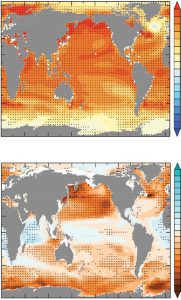Declines in oxygen levels of coastal waters have accelerated in recent decades creating 'dead zones' not only in more publicized nearshore areas but in open ocean offshore regions of the continental shelves and slopes. Once treated as separate phenomena and distinct fields of study, scientists now see offshore and coastal hypoxia as interconnected, resulting in complex ecological responses.

Top. Coastal hypoxia and predicted change in sea surface temperature. Vertical scale is change in the number of degrees Celsius from 0.0 to 4.0 (temperature increases 0.0 to +4.0, yellow to red; temperature decreases 0.0 to -4.0, blue to purple). Bottom. Predicted change in oxygen concentration at 200-600 meters. Vertical scale is number of molecules of oxygen in a micromole. Dissolved oxygen increases 0 to +50 micromoles, white to green; dissolved oxygen decreases 0 to -50 micromoles, pink to dark red. (Credit: L. Levine and D. Breitburg via permission of K. Gedan and L. Bopp)
Scientists sponsored by NCCOS are studying the causes, interconnections, and impacts of hypoxia. Along with other members of the scientific community, they are finding that climate change caused by increasing carbon dioxide levels is lowering pH (increasing acidity) and calcium carbonate concentrations, warming water temperatures, and increasing dead zones in both realms. Both coastal and deeper ocean hypoxia are predicted to worsen with increasing global temperatures.
Nutrient-enriched coastal dead zones can worsen oceanic hypoxia and vice versa. Increasing coastal primary production of phytoplankton fuels microbial decay and respiration in deeper offshore waters, worsening oceanic hypoxia. Likewise, wind-induced upwelling related to atmospheric warming is bringing hypoxic waters to nearshore areas. As a result, areas of continental margins, shelves, and estuaries that were previously well-oxygenated now experience seasonal or sporadic dead zones. Future understanding and management decisions will require better integration of currently fragmented oxygen observation and research programs.
A commentary on and the latest scientific review of increasing oxygen loss in both the ocean and coastal waters is published in the journal Nature ClimateChange.
For more information, contact David.Kidwell@noaa.gov.
 Official websites use .gov
A .gov website belongs to an official government organization in the United States.
Official websites use .gov
A .gov website belongs to an official government organization in the United States. Secure .gov websites use HTTPS
A lock or https:// means you’ve safely connected to the .gov website. Share sensitive information only on official, secure websites.
Secure .gov websites use HTTPS
A lock or https:// means you’ve safely connected to the .gov website. Share sensitive information only on official, secure websites.